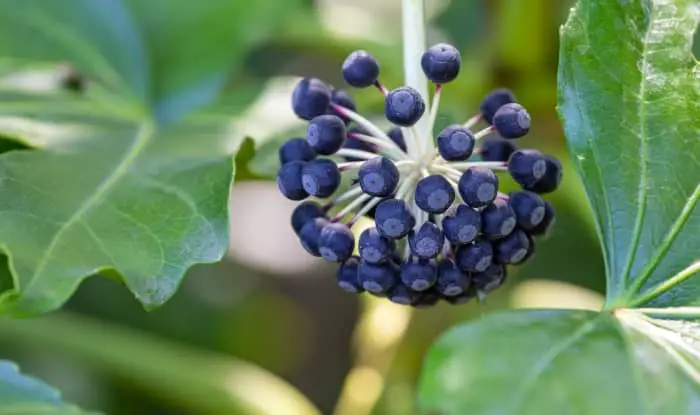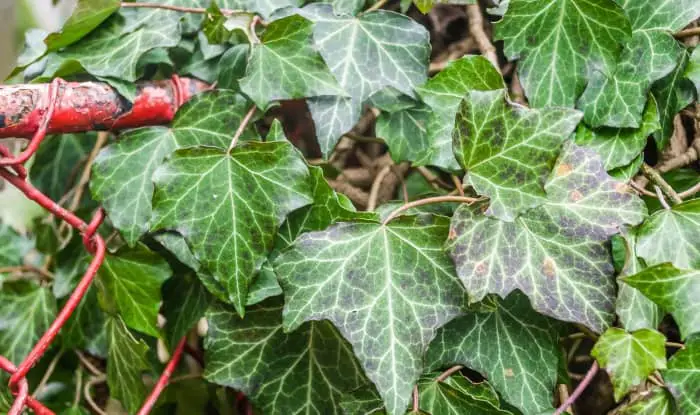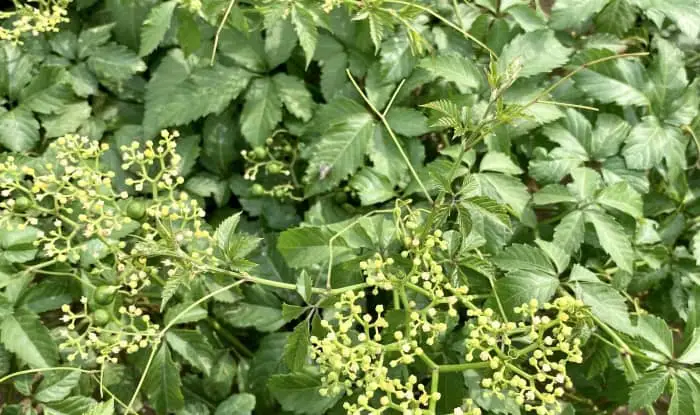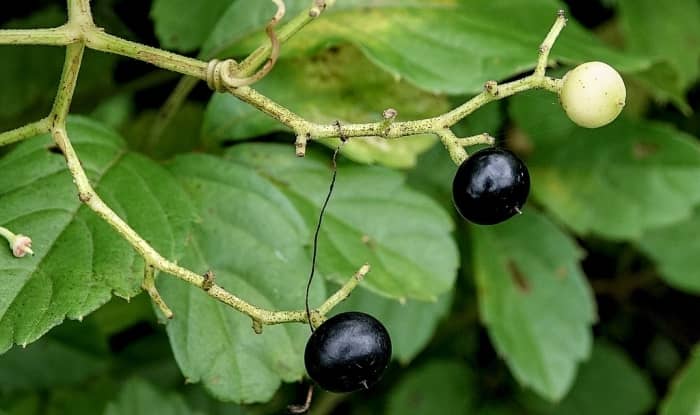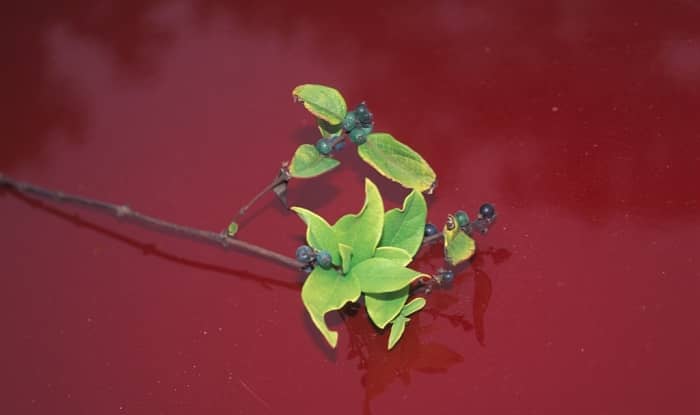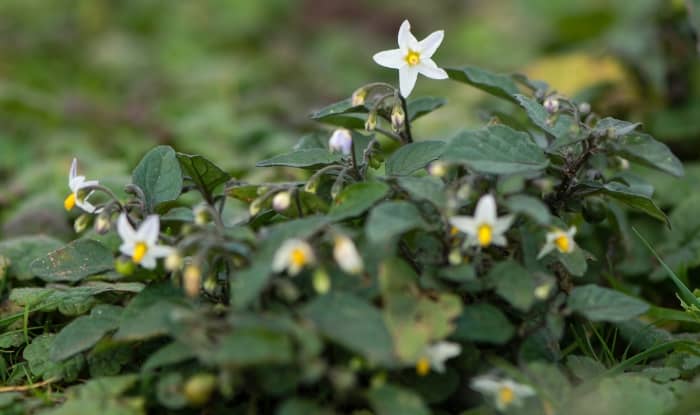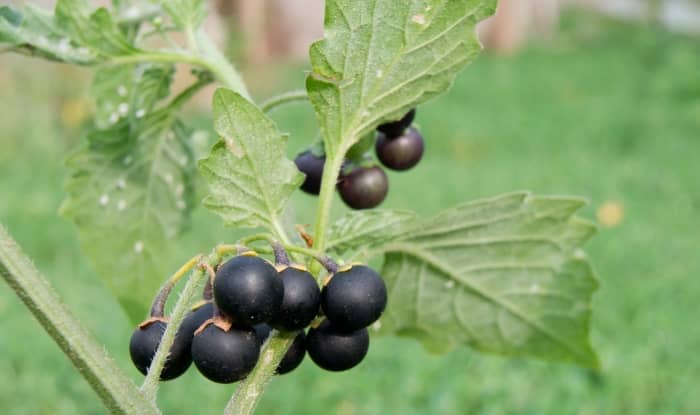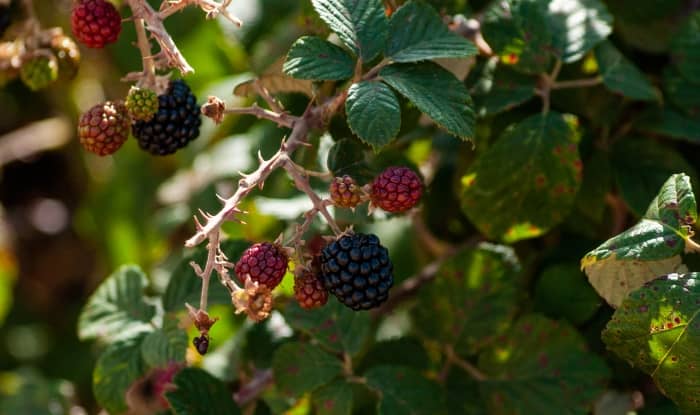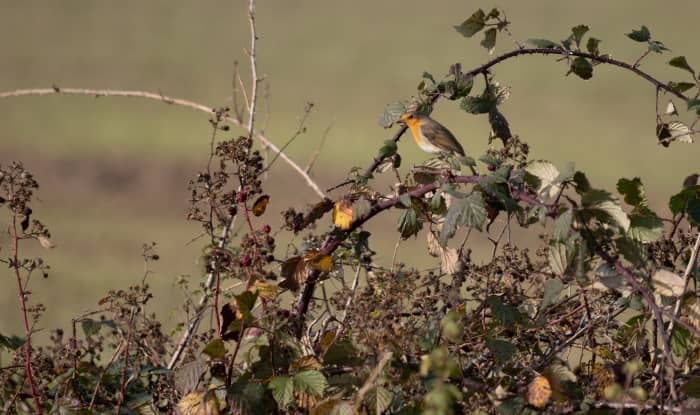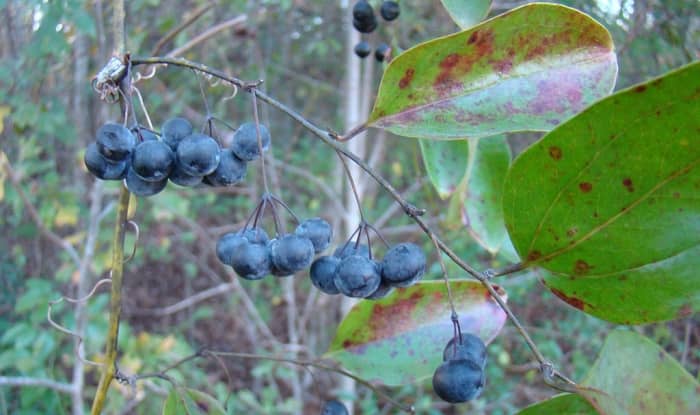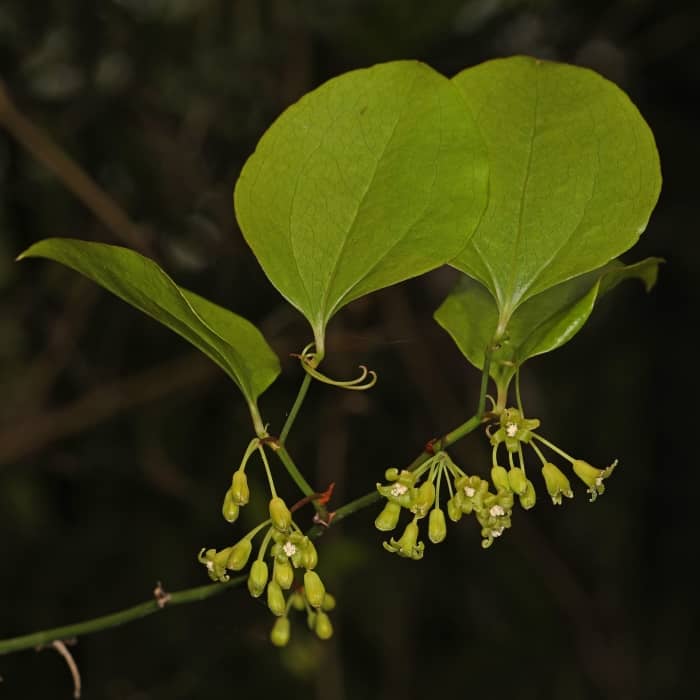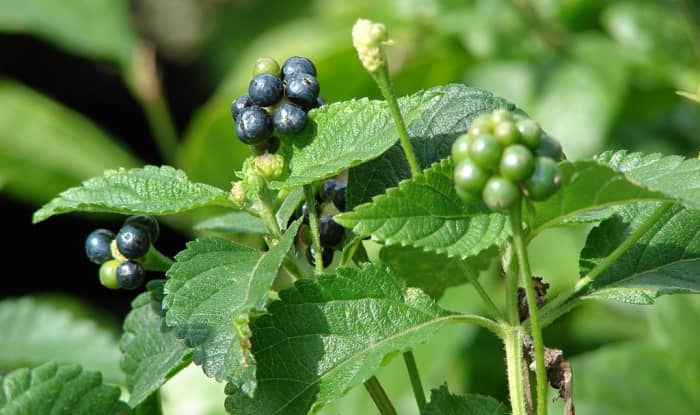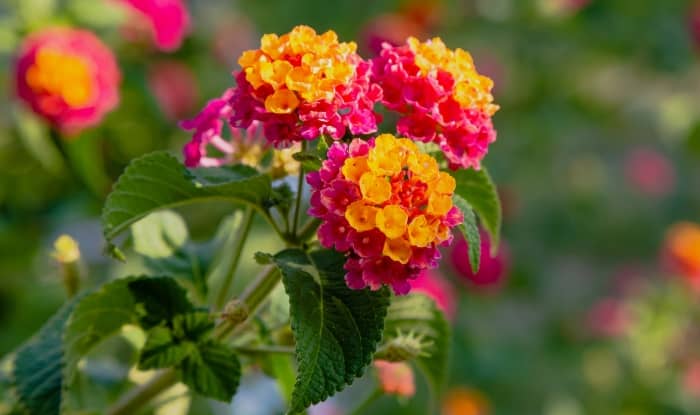Have you discovered some weeds with black berries growing in your yard?
In this list, we take a look at the most common types and help you identify them using photos and descriptions.
Let’s dive in.
Weeds With Black Berries
Weeds with black berries can be edible or poisonous plants, so it’s helpful to know which species you’re dealing with.
Here are some of the most common types:
Deadly Nightshade (Atropa belladonna)
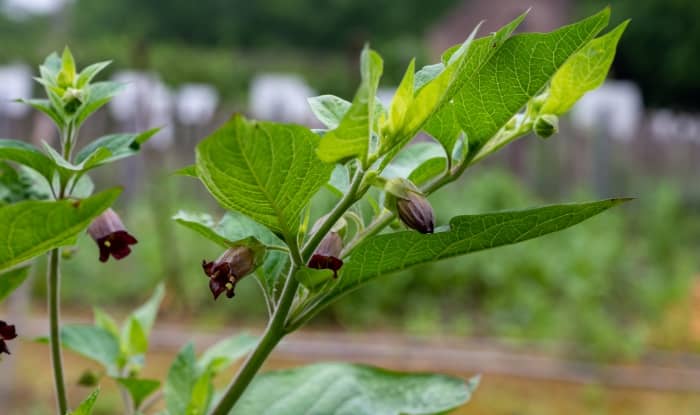
Caution is advised if you come across this weed. Also known as belladonna, deadly nightshade is notorious for being a highly poisonous weed with black berries.
All parts of the plant are toxic. Eating the weed’s sweet-tasting black berries can be fatal, and even just handling deadly nightshade can make you ill from toxins that pass through the skin. If you’re lucky touching the plant will only lead to severe dermatitis.
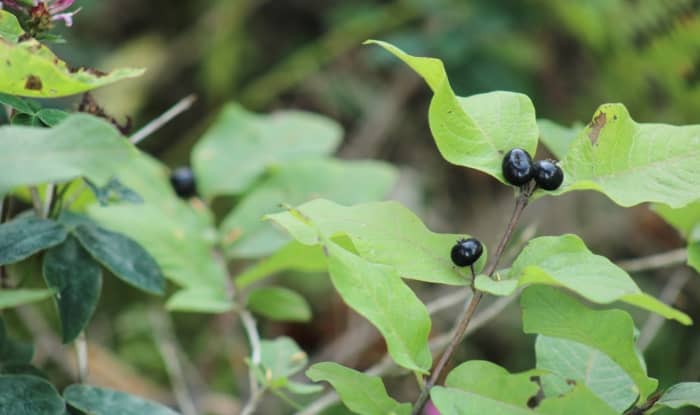
The berries are one of the most recognizable parts of the weed. At first green, deadly nightshade berries turn black and shiny as they ripen, resembling cherries.
Before the black berries appear, deadly nightshade is easily identified by its purple bell-shaped flowers, that bloom from June to September. After flowering, the fruit quickly appears.
The weed has pale green, oval-shaped leaves that are pointed and ribbed. The leaves have smooth edges and grow alternately from the stem.
Deadly nightshade is often seen in woodlands, scrubland, and growing along paths and banks.
Virginia Creeper (Parthenocissus quinquefolia)

Virginia creeper is a perennial woody vine weed with black berries often found around orchards, vineyards, and gardens.
Virginia creeper is a fast-growing vine that’s sometimes mistaken for poison ivy. But unlike poison ivy, Virginia creeper has five leaflets making up its compound leaves that taper to a pointed tip with saw-toothed edges. And Virginia creeper doesn’t produce urushiol oil, the skin irritant that poison ivy is notorious for. But it does produce sap that causes a skin rash in highly sensitive people.
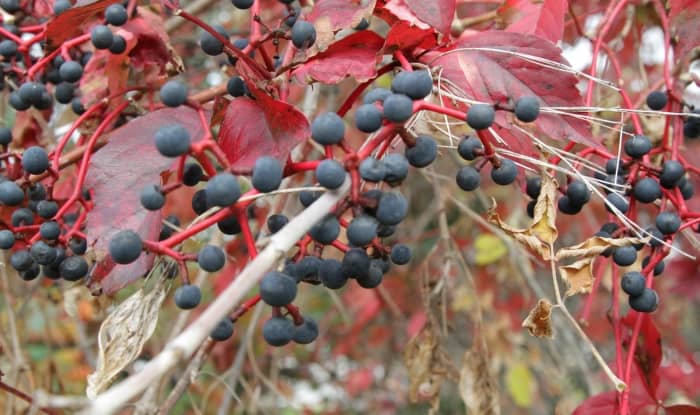
Virginia creeper grows well in full sun to full shade and can climb up to 30 ft. with adhesive pads at the end of tendrils holding the vine in place. When Virginia creeper blooms, it produces clusters of yellow flowers at the end of green-red stalks.
In the fall, Virginia creeper leaves turn red, and the flowers give way to dark blue-black berries at the end of the now bright red stalks. The berries are poisonous, so don’t eat them. But every part of the plant is toxic, containing oxalate crystals. In particular, the seeds, seed pods, and leaves have high oxalate crystal levels.
American Pokeweed (Phytolacca Americana)
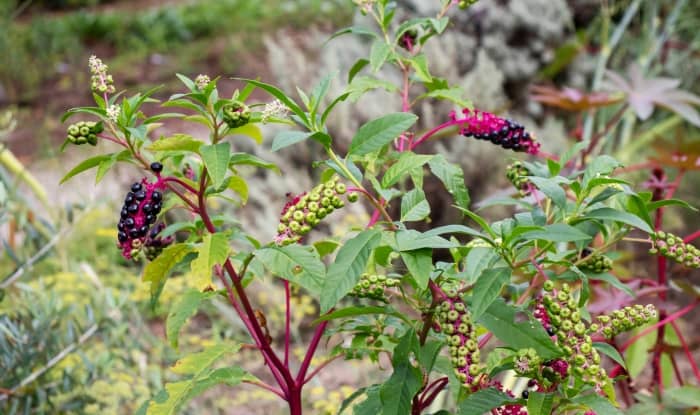
Also called pokeberry, pokeweed is a large and problematic perennial broadleaf weed. Pokeweed is an invasive weed because it can spread rapidly in an area, growing in dense, tall bushes that crowd out and displace other plants.
You can easily identify pokeweed when it bears fruit. Pokeweed has attractive, purple-black berries that are tempting to eat, but make sure you don’t. Every part of pokeweed is toxic, including the poisonous berries.
Pokeweed is sometimes used as a traditional folk remedy for skin complaints, joint pains, and tonsilitis. But this isn’t a safe weed to use for medicinal purposes.
The poke berries contain seeds that help the weed to spread. So even if you don’t remove the plant, it’s worth removing the fruit, especially if you have young children who might put the berries in their mouths.
When pokeweed isn’t producing fruit, you can recognize the weed by its thick red stems, green-white flowers, and large green leaves with long petioles.
For more weeds with purple berries, check out our identification guide.
English Ivy (Hedera helix)
Native to many parts of Europe and western Asia, English ivy is used by some gardeners as a low-maintenance ground cover. But it’s also considered a noxious and invasive weed in many parts of North America and Australia.
English ivy is an evergreen, perennial woody vine that easily escapes from gardens, invading nearby forests, parks, and other natural areas where it chokes out and displaces native vegetation, creating ‘ivy deserts’ (1).
English ivy vines trail or climb and can grow up to 100 feet with stems that reach 1 foot wide. The dark green leaves grow alternately and have whitish veins. The leaves vary from unlobed to 3-5 lobed.
English ivy is a weed with round black berries, that are fleshy, with a hard stone-like seed in the center. The black berries usually ripen over the winter. Don’t eat the berries — they’re poisonous.
The plant produces small greenish-yellow flowers from late summer to early fall, growing in clusters at the tips of flowering stems.
Bushkiller Vine (Cayratia japonica)
Bushkiller is a perennial vine that’s native to Asia and Australia but is now present as an invasive climbing weed with black berries in some states in the US.
Bushkiller vine has compound leaves that consist of 5 leaflets, which sometimes leads to people misidentifying the plant as Virginia creeper (2). One way to tell the difference is that the central leaflet doesn’t have its own stem on Virginia creeper.
Orange or salmon-colored flowers are visible in late summer. The flowers are small and develop in clusters. The flowers produce small, grape-like black berries, each containing 2-4 seeds.
CAYRATIA JAPONICA BY PHONON.B, CC BY 4.0, VIA WIKIMEDIA COMMONS
Bushkiller climbs nearby structures and trees, producing dense foliage that can block sunlight to nearby plants. The troublesome viney weed also competes with desirable plants for nutrients and water from the soil, reducing their growth.
Common places to find bushkiller vine growing are disturbed ground in residential areas, fallow fields, harvested forests, and overgrazed pastures.
Purple Leaf Japanese Honeysuckle (Lonicera japonica ‘Purpurea’)
Purple leaf Japanese honeysuckle is a sprawling vine that grows fast. The climbing weed quickly covers outbuildings, walls, and other obstacles that get in its way. The weed also forms a thick ground cover when unsupported.
Forest & Kim Starr, CC BY 3.0 US, via Wikimedia Commons
The twining stems have dark green leaves that are tinged with purple. It blooms from spring through to late summer, producing fragrant purple-red flowers with white interiors. The flowers eventually give way to small purple-black berries.
Black Nightshade (Solanum nigrum, Solanum ptycanthum, Solanum americanum)
There are three closely related plants called black nightshade (3) in North America, sharing similar characteristics:
- European black nightshade (Solanum nigrum), also called blackberry nightshade, is native to Eurasia and an introduced species in other parts of the world.
- American black nightshade (Solanum americanum), also called glossy nightshade, is native to the Americas, Melanesia, and Australia.
- Eastern black nightshade (Solanum ptychanthum), also called West Indian black nightshade, is native to North America. This weed with black berries is found widely, growing in all US states apart from Oregon, Nevada, California, and Washington state. You can also find it growing in the southern provinces of Canada.
The black nightshades are broadleaf annual weeds with small black berries that grow in clusters. The weeds have leaves that grow alternately on short stalks.
Some strains of black nightshade are poisonous while others are edible weeds. The plants also resemble deadly nightshade, so unless you know what you’re doing, make sure you don’t eat the juicy black berries or other parts of the plant.
You’ll often find black nightshade growing in areas of rich soil. Which might include your lawn and garden. But you’re also likely to see it along roadsides, river banks, and areas where the soil is disturbed, such as cultivated land.
Wild Blackberry (Rubus spp.)
Also called brambles, there are a number of species of wild blackberry that are weeds, including the non-native species Himalayan blackberry (Rubus armeniacus), and cutleaf blackberry (Rubus laciniatus).
There are also native species of wild blackberry sometimes considered weeds, such as Western thimbleberry (Rubus parviflorus) which causes problems in reforested areas by competing with conifers, and Pacific blackberry (Rubus ursinus), known for infesting areas next to ditches and streams.
Of these weedy wild blackberry species, Himalayan blackberry is the most troublesome and common.
You’ll often find wild blackberry bushes growing in neglected areas, forming dense bramble thickets of impenetrable tangled woody stems.
Wild blackberries tend to grow best in sunny locations but still thrive in partial shade, developing arching stems that grow up to 8 ft. long. The bramble stems are stiff like canes and root in places where the tips touch the soil.
Wild blackberries don’t flower or produce fruit until their second year of growth. But when they do, you’ll notice the weeds have black juicy berries that are popular with people who forage for wild berries, because unlike many other weeds with black berries, they are edible.
Common Greenbrier (Smilax rotundifolia)
COMMON GREENBRIER BY FRANKLIN BONNER, USFS (RET.), BUGWOOD.ORG, CC BY 3.0, VIA WIKIMEDIA COMMONS
Common greenbrier is also known as catbrier or roundleaf greenbrier. Common greenbrier is native to Eastern and South-Eastern North America, and you’ll usually see it growing in woods and forests.
This weed has long woody vines with large black-tipped thorns. In the fall, the weed produces bluish-black berries that grow from the vines in loose bunches and stay throughout the winter, often lasting until spring.
The vines grow up to 25 feet long, are hard like canes, and are pale green in color. The vines grow over the ground and climb over objects and vegetation with the help of small tendrils.
COMMON GREENBRIER BY JUDY GALLAGHER
The leaves are green, glossy, and oval-shaped, growing from the stems on petioles. Depending on the location, the plant flowers sometime from April to June, producing greenish-white flowers that grow in clusters of 3-20 flowers.
Lantana (Lantana camara)
FOREST & KIM STARR, CC BY 3.0, VIA WIKIMEDIA COMMONS
Lantana is native to the tropical Americas but was introduced as an ornamental in many southern states in the 19th century. Lantana is now naturalized throughout the South East from Florida to Texas, where it often has a reputation for being a troublesome invasive weed. Commercial varieties sold as ornamentals are now sterile and non-invasive.
Lantana plants are perennial shrubs well-known for their bright, colorful flowers that bloom throughout the growing season and small shiny black berries, each containing two seeds. The flowers have 4-petals and can be orange, white, or pink, with different colored flowers sometimes growing in the same cluster (4).
Lantana is a tall weed with black berries, growing from 6-15 feet. Ovate leaves grow opposite along square stems and produce an unpleasant odor when crushed.
Lantana quickly invades disturbed sites. The plant is allelopathic, producing chemicals in the roots and stems that inhibit the growth of nearby competing plants.
The toxins produced by the plant also make the leaves poisonous for animals to consume. But the black berries are edible when completely ripe.
Read More:
References:
- Hedera helix – https://en.wikipedia.org/wiki/Hedera_helix
- Bushkiller – https://extension.msstate.edu/publications/bushkiller
- Black Nightshade – https://en.wikipedia.org/wiki/Black_nightshade
- Largeleaf lantana – https://www.invasiveplantatlas.org/subject.html?sub=3031
